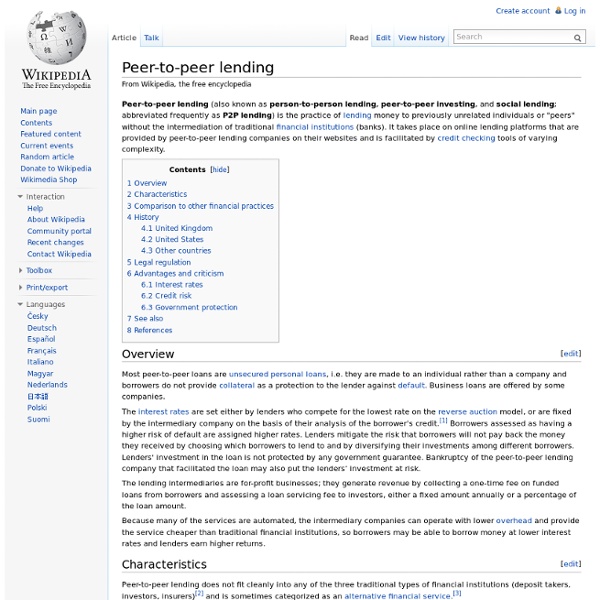Peer-to-peer lending

Peer-to-peer lenen
What is Kickstarter
1. Kickstarter is a new way to fund creative projects. We’re a home for everything from films, games, and music to art, design, and technology. Kickstarter is full of projects, big and small, that are brought to life through the direct support of people like you. Since our launch in 2009, 6 million people have pledged $1 billion, funding 60,000 creative projects. 2. The filmmakers, musicians, artists, and designers you see on Kickstarter have complete control over and responsibility for their projects. 3. Project creators set a funding goal and deadline. 4. Backers are supporting projects to help them come to life, not to profit financially. 5. Mozart, Beethoven, Whitman, Twain, and other artists funded works in similar ways — not just with help from large patrons, but by soliciting money from smaller patrons, often called subscribers. 6. It’s supporting their dream to create something that they want to see exist in the world. 7.
Cyclos: software voor online en mobiel bankieren
STRO ontwikkelde in 2003 de eerste versie van Cyclos: software voor transacties in lokaal geld projecten.De allernieuwste versie van Cyclos biedt deelnemers de mogelijkheid van transacties met lokaal geld via PC, betaalkaart of mobieltje. Honderden lokale bedrijfsnetwerken en lokaal geld projecten wereldwijd gebruiken Cyclos inmiddels naar volle tevredenheid Mogelijkheden van CyclosMet Cyclos kunnen leden van lokaal geld projecten zonder tussenkomst van derden transacties verrichten met een intern ruilmiddel. Cyclos heeft vele functionaliteiten, zoals een marktplaats voor vraag en aanbod, liquiditeitsheffing om geld te laten rollen, beoordelingen van transacties, etc.Programmeurs kunnen relatief makkelijk nieuwe functionaliteiten aan het bestaande systeem toevoegen. Cyclos voor lokaal geld initiatieven in NederlandVoor lokaal geld initiatieven zoals LETS-groepen biedt Cyclos de mogelijkheid om zonder tussenkomst van derden transacties te verrichten en advertenties te plaatsen.
The 5 Keys To Business Success | Create Your Business Breakthrough
Diane Conklin Title: The 5 Keys To Business Success Diane Conklin is an internationally known author, entrepreneur, coach, consultant, and speaker. Diane is a direct response marketing expert who specializes in showing small business owners how to integrate their online and offline marketing strategies, media and methods, to get maximum results from their marketing dollars. Diane has been involved in numerous campaigns grossing over $1,000,000.00 several times in her career and routinely helps people grow businesses to 6 figures, and beyond in short periods of time. Diane was voted Glazer-Kennedy Marketer of the Year for her innovative marketing strategies and campaigns. Diane's Free Gift for Create Your Business Breakthrough Viewers! Free Gift:“The 9 Key Building Blocks For Starting & Building Your Information Marketing Business”: www.CompleteMarketingSystems.com
Related:
Related:



